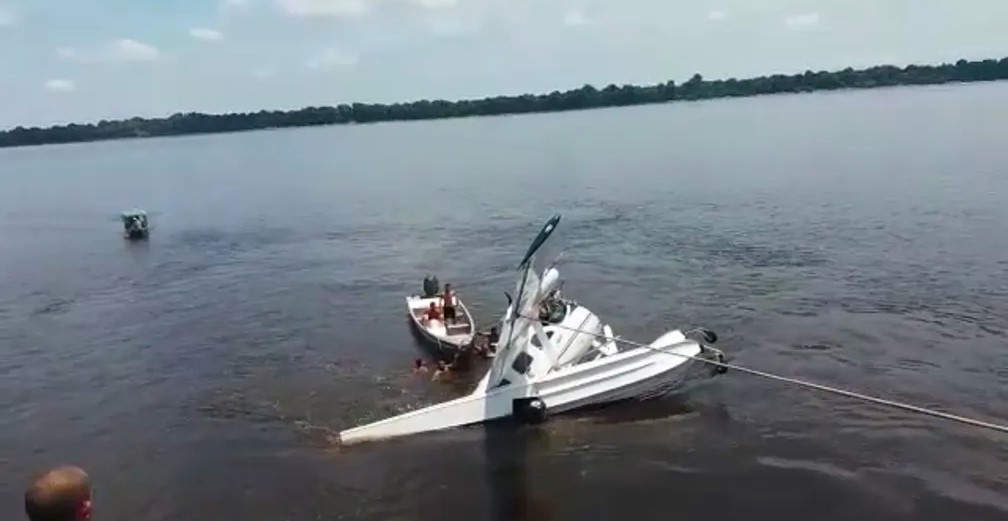


The Federal Court of Amazonas sentenced to eight years in prison the pilot who flew the Greenpeace plane that crashed in Rio Negro near the city of Novo Airão in 2017, that lead to one person's death.
The aircraft, a Cessna Caravan 208 amphibious model, with registration PR-MPE, overturned and sank into the river after attempting a water landing with the landing gear down.
The accident would not have occurred if the pilot had carried out the basic safety checklists, which are mandatory and must be done with the aircraft still on the ground and before the landing procedure.
The conviction information was released by the Federal Public Prosecutor's Office (MPF), the plaintiff in the lawsuit, which alleged an attack against air security with the so-called "eventual malice".
The accident occurred in the region of the Anavilhanas Archipelago. At the time, the aircraft overturned and sank in the river after trying to land in the water.

Anac reported that according to data from the Brazilian Aeronautical Registry (RAB), the Annual Maintenance Inspection (IAM) and the Certificate of Airworthiness (CA) of the aircraft were valid, that is, the aircraft was regular and, therefore, fit to fly.
Three people were injured and one died – Sweden's Carolina Steiser, a member of Greenpeace.
The court concluded that the pilot failed to perform a series of mandatory checklists when the aircraft – a Cessna Caravan 208 amphibious model – was still on the ground.
According to the MPF, the pilot "was fully aware of the insecurity generated by the failure to carry out the checklists, but chose to proceed with the operation."
"In the case of dangerous activities, they can only be carried out safely when the legally established procedures are respected. Not respecting them is creating a danger of harm to oneself and to third parties," the MPF said in the complaint.
The pilot of the aircraft was sentenced to eight years of imprisonment, in a semi-open regime, that is, retiring to prison only at night. The decision can be appealed by the Federal Prosecutor's Office and the defense.
The MPF clarifies that the defendant is considered innocent until the final and unappealable criminal decision that definitively recognizes his guilt, that is, when there are no more appeals to be presented.
Failure to comply with the checklist during the pre-flight inspection and the flight itself favored the landing with inadequate configuration. This attitude may have been triggered by the pilot's confidence in his operational capability, because of his long experience in aviation.
Failure to comply with the checklist indicated, in addition to the low level of situational awareness, a low level of concern for the safe conduction of the flight by failing to follow basic procedures set forth in the manufacturer's manuals and current regulations.
The pilot's choice not to use the checklist during the flight phases revealed an inadequate evaluation of parameters related to the operation of the aircraft.
Improper compliance with the items in the Pre-Flight Inspection Sheet prevented the AMPHIB PUMP 1 and 2 circuit breakers from being rearmed.
After performing the test of landing gear extension and retraction by the emergency system, the AMPHIB PUMP 1 and 2 circuit breakers were not rearmed, being the aircraft delivered to fly in this condition
The setting recorded on the AIRSPEED switch of the landing gear position warning system computer demonstrated that the scheduled speed of 74kt was not in accordancewith the recommended in the 9600-1A installation manual of Wipaire Inc. in its revision G.
The AMPHIB PUMP 1 and 2 circuit breakers were found disarmed after the occurrence, indicating that, after the completion of the maintenance service, the executor of the tasks probably forgot to comply with the procedures for reconfiguring the aircraft.
In addition, it is possible that the pilot's automatism in relation to his way of carrying out the air operations, without the use of the checklist, has prevented the correct perception of the circuit breakers condition and the erroneous positioning of the landing gear.
The accomplishment of the landing on the water with the aircraft in inadequate configuration for the situation denotes a decrease in the level of situational awareness of the pilot, considering that the necessary factors and conditions for the safety of the operation were not observed.
